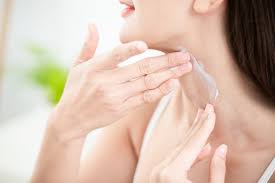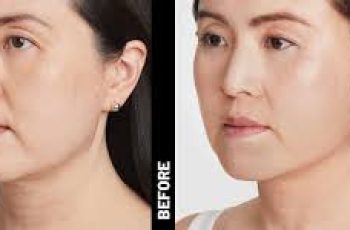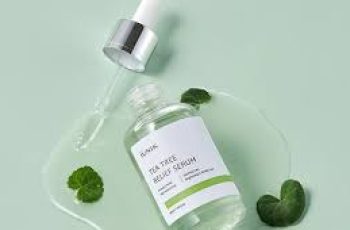Can You Use Mandelic Acid on The Neck?
Using a daily skincare routine will often consist of moisturisers, serums, and sometimes treatment face masks. We spend a lot of time and energy applying these potent formulas to keep the skin looking and feeling its best. The problem is that a lot of the time, areas such as the neck are completely forgotten about.
This may not sound like something too drastic, but believe it or not, the skin around our necks is considerably thinner meaning it can show signs of ageing a lot sooner. There are also many different factors that can contribute to the accelerated ageing of the neck. The way we sleep, our lifestyles, how long or often we look down at a computer or iPhone, even how often you spray perfume can cause discolouration.
So, we will be exploring into finding out how using certain ingredients, and whether you can use mandelic acid on the neck.
What is Mandelic Acid?
Derived from bitter almonds and is a member of the extensive family of chemical exfoliants, called AHAs.
Compatible with many different skin types, including those prone to sensitivity.
Helps to accelerate skin cell turnover, ridding the skin of excess sebum, dirt, bacteria, and other impurities leaving you with a healthy, glowing complexion.
Packed with anti-inflammatory properties making it highly effective at targeting acne and other forms of breakouts.
Combats areas of hyperpigmentation, dark spots, and sun damage, with proven results of a more even skin tone after 4 weeks.
Helps to stimulate collagen production to help iron out the appearance of fine lines and wrinkles.
Improves skin texture removing dead skin cells and leaving the overall skin firmer and smoother.
Although it is thought to be one of the gentlest acids, it is still advisable to consult with a doctor or dermatologist before introducing mandelic acid to the skin. If you wanted to find out more about the clever AHA, check out our dedicated blog post.
Can you use mandelic acid on your body?
Yes, it can, in fact, because the molecular size of mandelic acid is twice the size of glycolic acid, and a third larger than lactic acid, it is one of the gentlest acids available. This results in limited amounts of irritation and redness, with a slower absorption meaning all skin types can use it on any suitable area on their body.
Quite often formulated into body care products such as moisturisers and specialist shower gels, mandelic acid can get to work reviving the skin and leaving it with all-over improved clarity. As I have already mentioned, the speed of absorption is a little slower than other acids, however, mandelic acid is still able to work its way deep into the lower layers of the skin enabling the benefits of the acid to get to work. These benefits are the stimulation of collagen production, sloughing away the layer of dead skin cells, and inhibiting the overproduction of melanin preventing dark spots becoming more pigmented, and finally helping the complexion to become clearer and acne-free.
All these concerns are not limited to the face, and quite often affect areas of the body too, finding a body care product to help combat these will help keep the skin clear and in its healthiest state.
What can mandelic acid not be used with?
As mentioned, several times already, mandelic acid is one of the gentlest acids, but it is an acid, and this can still result in a flare-up in irritation, redness, severe dryness, and general discomfort. Therefore, it is important to remain mindful of layering mandelic acid with other acids, such as glycolic acid, salicylic acid, and potent actives such as retinol.
The reason for this is due to many factors, such each ingredient containing different pH levels, delivering similar results to the skin, and causing too much stimulation. Having said that, you are still able to use these actives in your routine, it is just a case of applying them at the right stage. Many experts suggest either alternating when you apply each ingredient or leaving enough time in between applications allowing the skin to settle and prepare for the next step in your routine.
As I would suggest for all new skincare products, the easiest way to establish there will be no side effects, is to perform a patch test for 24 hours. Apply a 10p amount of the product on your forearm and leave it there for 24 hours, if after that time you find there is no irritation caused, you can apply the formulation to the face.
How long do you leave mandelic acid on?
This is very much dependant on the product mandelic acid is formulated in. For example, if you are using a face wash or cleanser, it will usually be 5 minutes before the product is rinsed off the skin. For other products, such as serums and moisturisers, these remain on the skin for a longer amount of time, these are usually best left until your skin has built a tolerance for the acid, especially if you have a skin type that is highly sensitive and prone to flaring up.
If you have any concerns with any potential drying effects of using the acid, try teaming it with a hyaluronic acid as this will help keep the skin hydrated, happy, and lipid barrier functioning properly. This means it can protect the skin from any exposure to free radicals and other environmental aggressors.
Does mandelic acid help wrinkles?
Absolutely it can, this is due to the benefits this clever active is able to deliver to the skin. By stimulating the production of collagen, mandelic acid can help the skin become firmer, plumped, with a youthful bounce. You will also find it is able to rid the top layer of the skin of any build-up of dead skin cells, dirt, bacteria, and dry patches of skin. When these are left on the surface, fine lines and wrinkles appear worsened with a noticeable improvement once the dead skin cells are sloughed away.
If you have any further questions, don’t hesitate to come, and follow us on Instagram, you’ll find one of our skincare experts ready to help you.
DQH Knowledge drop: In your 20s, your skin cell turnover decreases. (Cell turnover is a key component in keeping your skin youthful.) You know what else slows down? Your collagen production. Starting in your 20s, collagen decreases by about 1 percent per year. Should you want to prevent fine lines and wrinkles, start by eliminating behaviors that contribute to premature aging. “If it’s bad for you, it’s bad for your skin,” says dermatologist Michel Somenek.
“Cigarette smoking reduces blood flow to the skin and causes premature wrinkling and a dull skin texture. Making the repeated pursed motion to inhale can also cause smoker’s lines. Alcohol and recreational drugs are toxins for the skin that damage its cellular structure and DNA,” Somenek tells us. “The faster you eliminate vices while you are young, the better chance your skin and body have to recuperate.” Also, adopting an anti-aging routine in your 20s is key. After all, the best offense is a good defense. We spoke to Somenek and experts Joshua Ross and Audrey Kunin to find out more.
Keep reading for the best anti-aging products for your 20s, according to skincare professionals.
Sunscreen
“We all know that the sun is the number one cause of skin aging and starting the prevention in your 20s is very important,” Ross says. “The majority of your sun damage won’t start to appear until you’re in your 30s, so don’t wait until you see it surface or you’ll be behind the curve. Stay ahead of it with a good-quality zinc-based sunscreen worn daily.”
Farmacy Green Defense Daily Mineral Sunscreen
An invisible sunscreen with SPF 30, plus botanical extracts meant to protect skin with tons of antioxidants. Bonus: It’s clean and fine to use under makeup.
Bareminerals Complexion Rescue™ Tinted Moisturizer Broad Spectrum SPF 30
Although we recommend you use your SPF and moisturizer separately, we also understand moments when you don’t have time or energy for that extra step. For those times, this bareMinerals moisturizer is a great thing to have on hand.
Vitamin C Serum
“A great introduction to anti-aging is to start with a vitamin C serum in your morning skincare routine,” Ross says. “It’s a powerful antioxidant that will neutralize free radicals and brighten the skin.” He adds that it’s a great way to counteract the effects of the sun’s harmful rays, which, as previously mentioned, are among the biggest causes of premature aging.
Drunk Elephant C-Firma™ Vitamin C Day Serum
The Drunk Elephant C-Firma is a lightweight serum that promises to give skin a glow by combining the brightening powers of vitamin C with ferulic acid, l-ascorbic acid, and vitamin E. The included sodium hyaluronate is meant to replace hydration loss, so you shouldn’t have to deal with any irritation.
Sunday Riley C.E.O. Rapid Flash Brightening Serum
This potent serum is jam-packed with vitamin C (15 percent, to be exact), which means it’s a potential superstar at both brightening skin and dousing it in antioxidants.
Peptides
Using peptides on your skin has many benefits, says Somenek. “The skin barrier is what defends the body against pollution, UV rays, bacteria, and toxins. It can be damaged by several everyday factors. Using topical peptides aids in building a stronger barrier,” he says. “Peptides comprise elastic fibers, which are a type of protein. These fibers help to make skin appear taut and firm. Peptides can also help repair damaged skin, relieve inflammation, and even out skin tone. Some peptides can kill acne-causing bacteria that is common in 20-somethings.”
Kunin agrees, saying, “Peptides are an excellent entry point for supporting collagen.” She recommends looking for face and eye treatments that contain these collagen-boosting powerhouses.
Charlotte Tilbury Magic Eye Rescue Cream
This Charlotte Tilbury super-emollient eye cream has a base of coconut oil and shea butter (read: it’s incredibly hydrating). Botanicals plus peptides are meant to help reduce dark circles and boost collagen, respectively.
This creamy moisturizer serves up potent collagen-boosting peptides and pycnogenol, and antioxidant-rich vitamin C. “Instead of sitting on top of the skin, peptides penetrate the outer layer so they go deep. The ‘signals’ they send tell the cells to produce elastin and collagen, which are needed for youthful-looking skin,” explains Somenek.
At-Home Peel Pads
Remember that skin cell turnover fiasco we talked about earlier? One way to help support it is by exfoliating. “Exfoliation is important to help keep skin fresh and luminous,” Kunin says. She recommends using at-home peel pads as an easy and effective way to exfoliate.
“The goal in your 20s is to fight the slowing pace of cell turnover. It is wise to use products that gently exfoliate, yet still remove oil and other impurities. Products that have Alpha Hydroxy Acids (AHA) or Beta Hydroxy Acids (BHA) are a good choice.”
According to Somenek, you should only exfoliate two to three times a week. “People of all ages are guilty of over-exfoliating and that can be too much of a good thing,” he says.
Dermadoctor Kakadu C Intensive Vitamin C Peel Pad
A few swipes of this Derma Doctor powerful peel pad promise to leave your skin glowing and smooth, thanks to the seven (yes, seven) types of chemical exfoliants, including AHA and BHA. It also contains vitamin C via Kakadu plum extract for added brightening and antioxidant protection.
KEY INGREDIENTS Kakadu plum extract is sourced from the Kakadu plum, a fruit grown in northern Australia. It contains vitamin C, which restores the skin’s natural barrier, increases collagen production, and soothes irritation.
Dr. Dennis Gross Skincare Alpha Beta® Universal Daily Peel Pads
These are the gold standard of peel pads, with a cult following and over 900 five-star reviews on Sephora. They’re easy to use and contain a blend of anti-aging exfoliating acids.
Emollient Night Cream
“In your 20s, you need to start upping the hydration in your skincare routine. You may have been cautious of over-moisturizing because of acne in your teens, but as you enter your 20s, your skin transitions and becomes drier,” Ross says. “I recommend an emollient night cream added into your evening skincare regimen.”
“Twenty-somethings need to make sure that they are not using creams that will clog their pores and cause excess oil production,” says Somenek. Opt for non-comedogenic products.
Cerave Skin Renewing Night Cream
One great choice is the CeraVe Skin Renewing Night Cream, which is a non-comedogenic night cream that leaves skin soft and glowy. It combines the moisturizing powers of ceramides and hyaluronic acid.
RoC Retinol Correxion Max Hydration Creme
“The best night cream ingredients contain retinol, benzoyl peroxide, and/or salicylic acid or hyaluronic acid. The goal is to moisturize, yet remove excess oil,” says Somenek. This Roc Retinol Correxion cream fits the bill as it contains both hyaluronic acid and retinol so it promises to moisturize while also being non-comedogenic.



